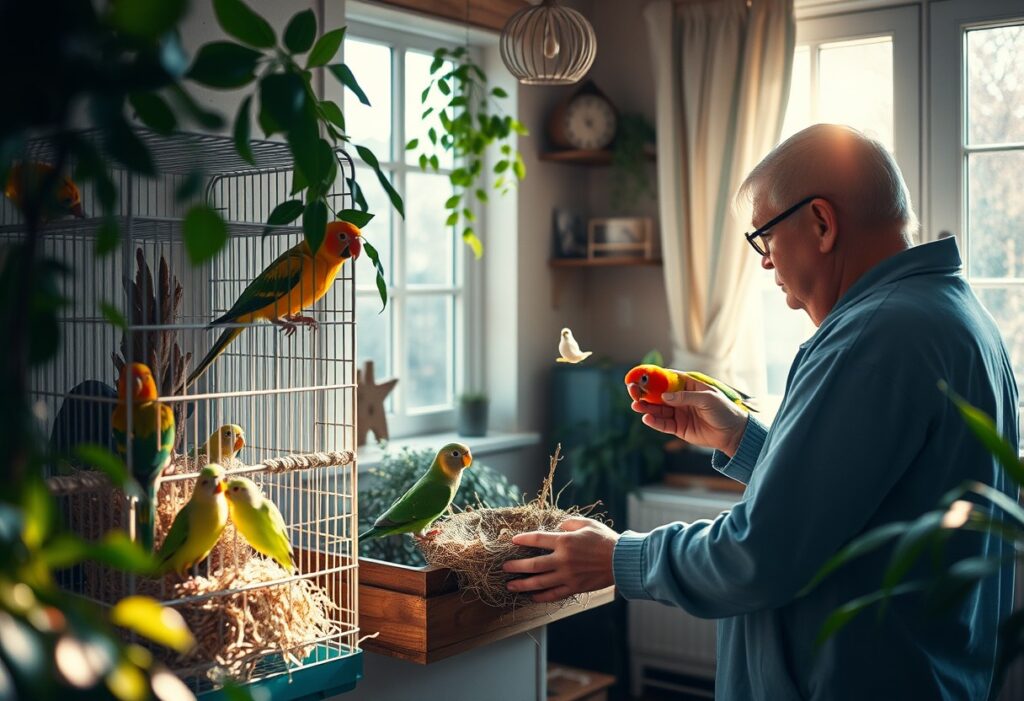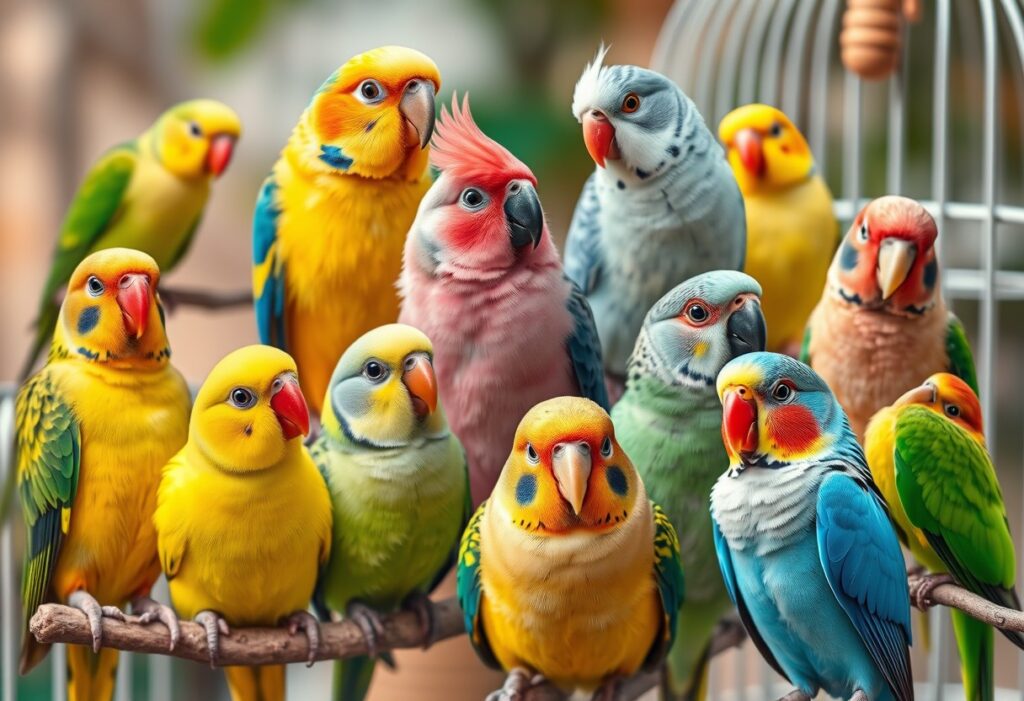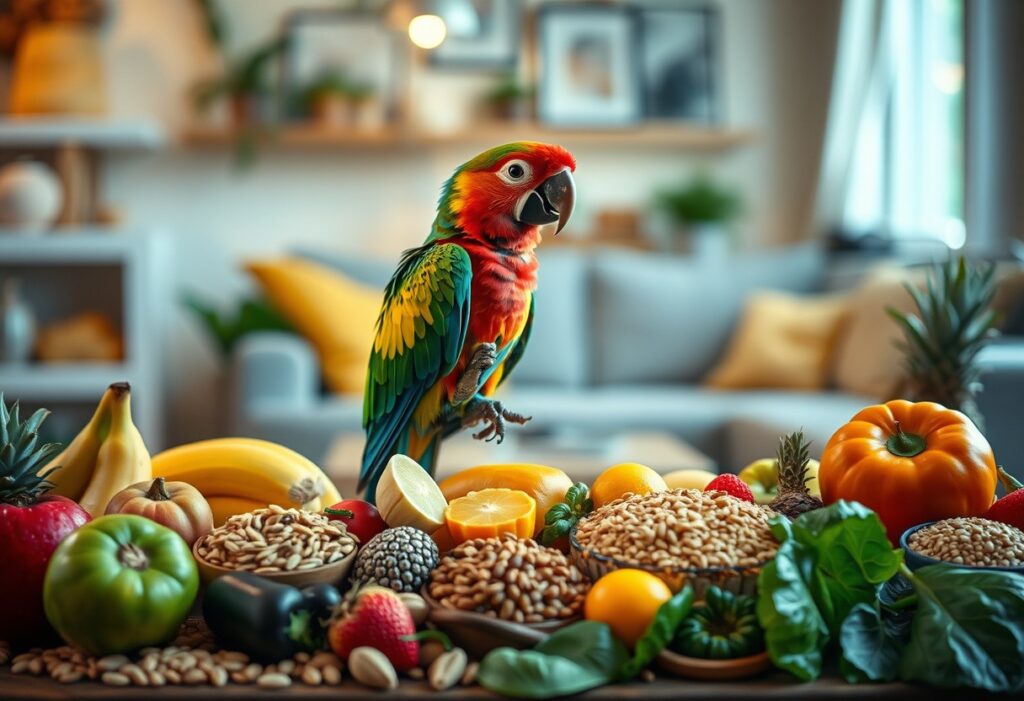Breeding birds at home can be a rewarding experience, but it requires careful planning and knowledge to ensure your feathered friends thrive. Understanding the right breeding conditions, maintaining a healthy diet, and being mindful of potential complications can significantly affect the success of the process. You will need to provide a secure and comfortable environment for your birds, as well as invest time in observing their behavior for signs of readiness. With the right approach, you can foster happy, healthy chicks and enjoy the beauty of bird breeding firsthand.
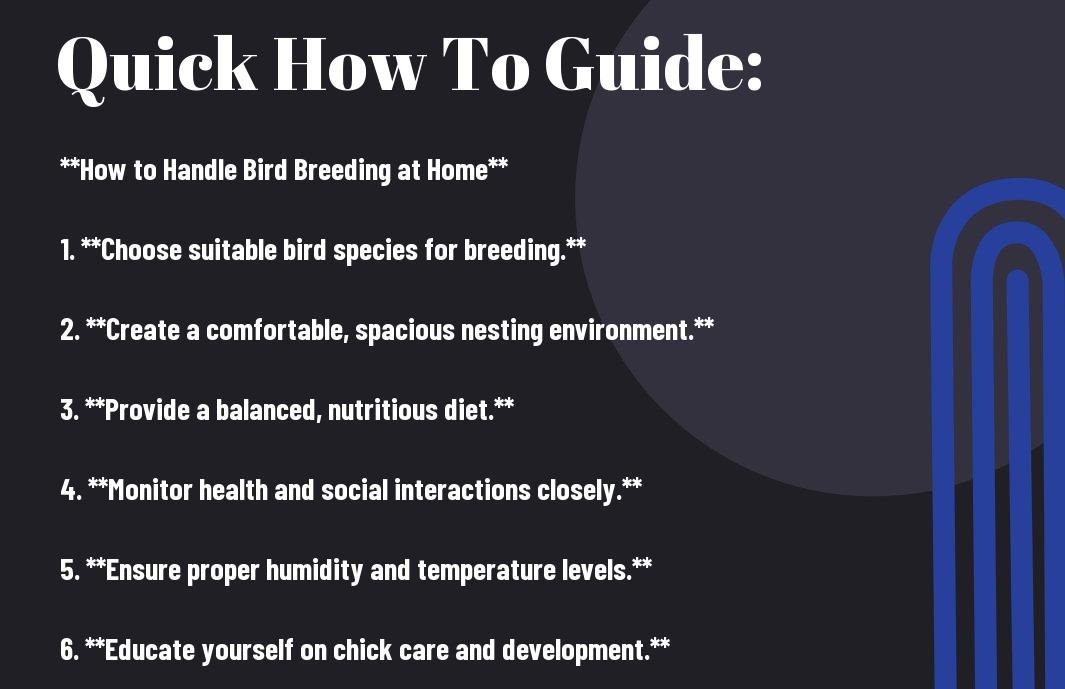
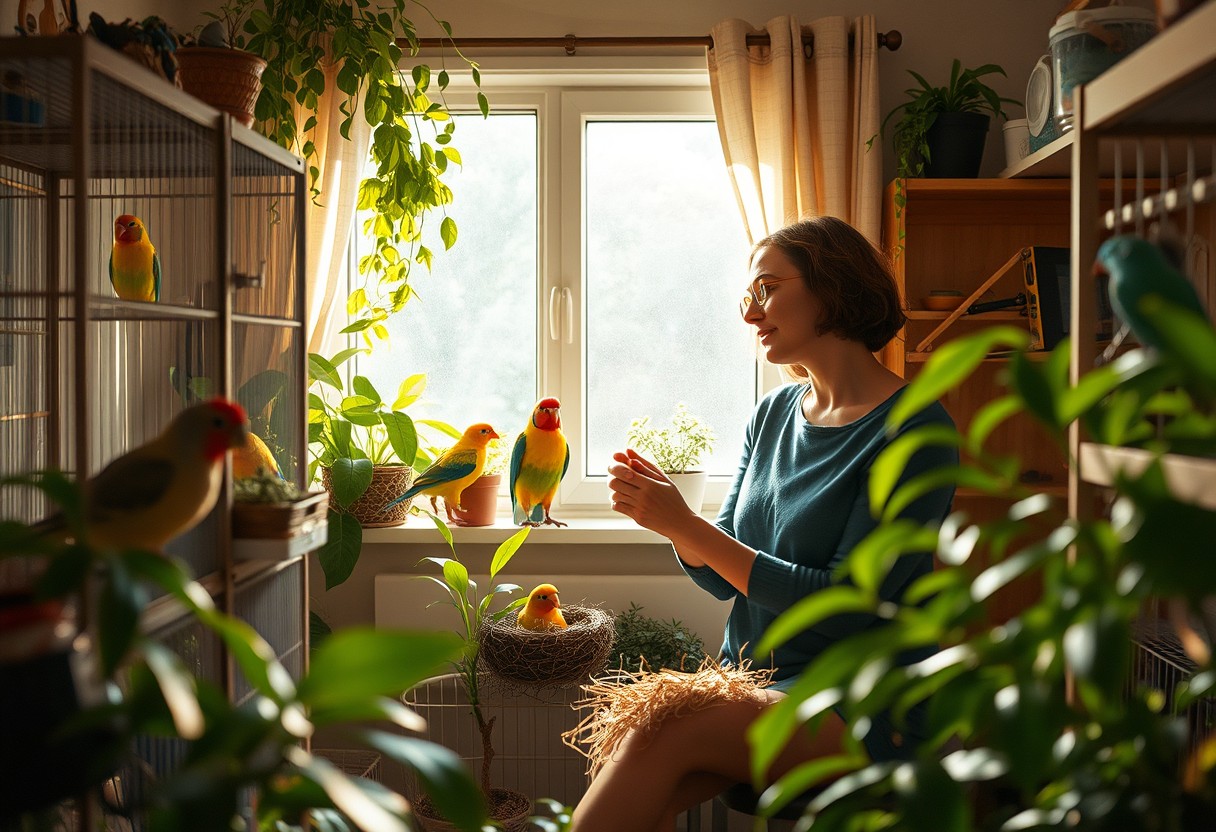
Understanding Bird Breeding
For anyone considering bird breeding at home, it is crucial to develop a solid understanding of the various aspects involved. One of the primary factors to consider is the importance of creating an appropriate environment for your birds. This includes ensuring that their aviary or living space is designed for their specific needs, as different species have varied requirements when it comes to space, cage size, and enrichment. A well-maintained environment not only promotes the overall health of your birds but also plays a significant role in their breeding success.
Importance of Proper Environment
Some key aspects of an appropriate breeding environment include temperature control, humidity, and lighting. Birds thrive in stable conditions. Therefore, you need to ensure that temperatures are kept within the recommended range for your particular species, as extreme heat or cold can lead to health issues and disrupt breeding behavior. Moreover, humidity levels should be monitored closely, especially during the breeding season when your birds may be more sensitive to dry air. Proper lighting also impacts breeding; birds generally require a natural day-night cycle to stimulate reproductive hormones, so keeping their environment well-lit during the day with access to dim light at night can help improve their reproductive success.
Choosing the Right Species
Choosing the right species is important for successful bird breeding at home. Each bird species has unique behaviors, requirements, and personalities, which can greatly influence your breeding experience. It is vital to research extensively and understand which species will work best with your lifestyle and expertise, taking into consideration factors such as vocalization, activity levels, and dietary needs.
Bird enthusiasts often overlook the importance of selecting a breeding pair that not only shares compatible traits but also has a healthy lineage. This means you should always acquire birds from reputable breeders or avian sanctuaries that provide clear information on the genetics and health of their stock. By doing this, you can help ensure that your birds are not only emotionally compatible, but also less likely to suffer from genetic diseases or behavioral issues during the breeding process. This careful selection will greatly enhance your chances of successfully breeding healthy, thriving chicks.
Setting Up the Breeding Habitat
Even though setting up a breeding habitat for your birds may seem daunting, taking the right steps can ensure a successful experience for both you and your feathered friends. The breeding environment is crucial to encourage healthy mating behaviors and nurturing of the young. If you want your birds to thrive during breeding season, it’s necessary to pay attention to the habitat’s details, including cage size, nesting materials, and environmental conditions.
Cage Size and Type
Clearly, the size and type of cage you choose are fundamental factors in creating a conducive breeding habitat. A spacious cage provides your birds with room to move, exercise, and display natural behaviors, which are important for breeding. Depending on the species, the ideal cage should offer at least adequate space for both pairs of birds, with enough room for nests without encroaching on each other’s territory. Also, make sure the cage is equipped with horizontal bars for climbing and enriched with perches at different heights.
Moreover, you may want to select a cage designed specifically for breeding. Such cages usually come with separate nesting compartments and are constructed to reduce stress levels among breeding pairs. The material of the cage is also crucial; avoid cages with galvanized metal, as this might release toxins that can harm your birds. Instead, opt for stainless steel or powder-coated cages that are both safe and easy to clean.
Nesting Materials
Breeding birds require various nesting materials to create a comfortable and secure environment for their eggs. These materials can include shredded paper, straw, grass, and suitable twigs or wood fibers. Birds are instinctively inclined to gather materials for building nests, so providing them with a selection is important. You can purchase pre-packaged nesting materials at pet stores or prepare natural options from your yard, ensuring they are free from pesticides and chemicals. By encouraging your birds to gather and arrange the nesting materials, you promote their natural breeding instincts and enhance the bonding experience between pairs.
With the right nesting materials, your birds will feel more secure and comfortable as they prepare to mate and care for their offspring. Make sure to maintain cleanliness by checking the nesting area regularly, cleaning out any old or soiled materials, and replenishing them as needed to keep your birds both safe and happy in their new breeding environment.
Temperature and Humidity Control
Even though it may seem trivial, controlling the temperature and humidity in your breeding habitat is vital for the health and well-being of your birds. Different bird species have varying temperature preferences; however, a general rule of thumb is to maintain temperatures between 70°F to 80°F (21°C to 27°C), ensuring you also monitor humidity levels between 40% and 60%. You can achieve this balance by using thermometers and hygrometers, both of which are important tools for any breeding setup.
Temperature and Humidity Guidelines
| Temperature Range | 70°F to 80°F (21°C to 27°C) |
| Humidity Range | 40% to 60% |
Control of these environmental factors is crucial because temperature fluctuations may lead to stress, egg infertility, or even death of hatchlings. It’s also important to avoid cold drafts or direct sunlight, as these can negatively impact the breeding process. Regular checks on both temperature and humidity can prevent mishaps and ensure a stable environment for your birds.
Key Environmental Controls
| Monitor Temperature | Use thermometers to ensure the right temperature range. |
| Adjust Humidity | Use humidifiers if humidity falls below desired levels. |
Control is paramount for successful breeding, so plan ahead by investing in quality monitoring devices and establish routines for regular maintenance of your breeding habitat. This proactive approach will mitigate any risks and furnish a safe haven for your birds, promoting better breeding outcomes.
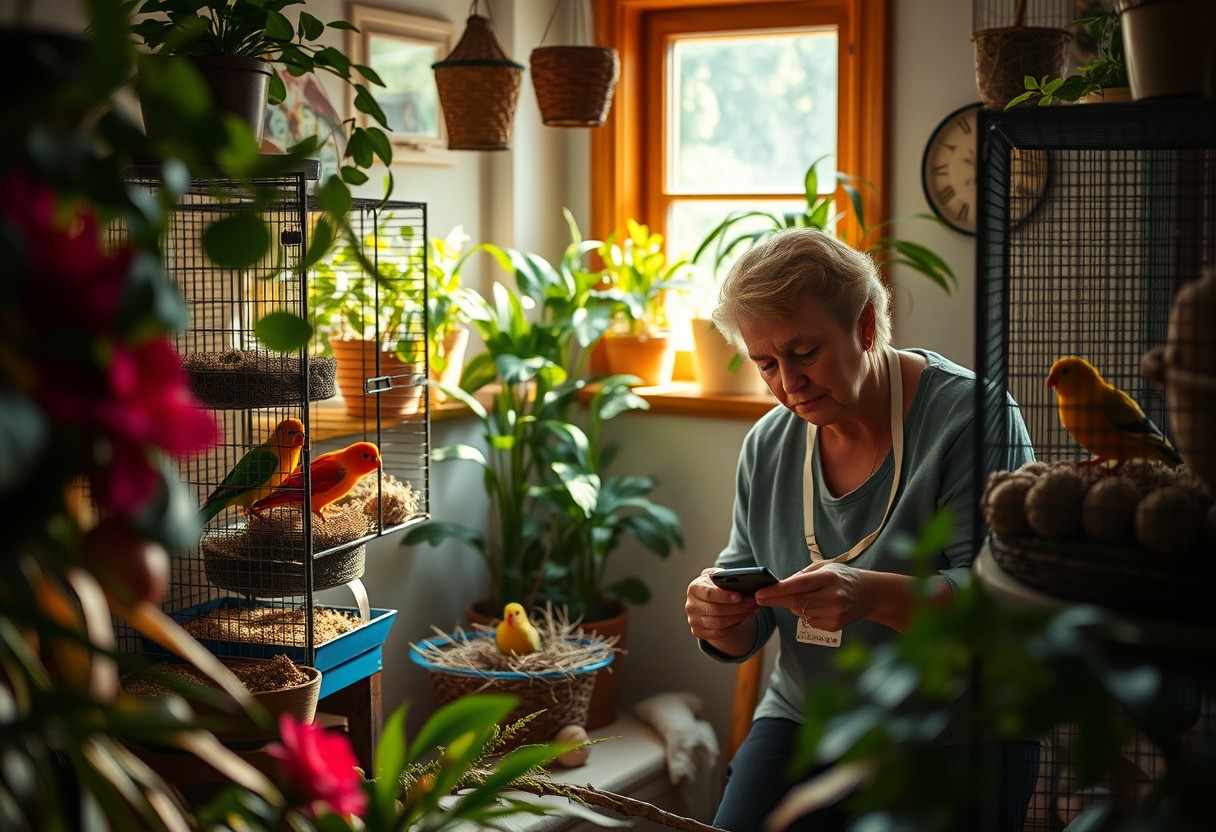
Essential Care During Breeding
Once again, creating a supportive environment for your birds during breeding is crucial for their health and the successful rearing of their offspring. During this period, you must pay particular attention to their nutrition, monitor their health and behavior closely, and handle the eggs and chicks with care. Essential care not only aids in the breeding process but also fosters a strong bond between you and your birds.
Nutrition and Diet
Some birds require a specialized diet during breeding to support egg production and the growth of chicks. Ensure that you provide a nutrient-rich diet that includes a variety of seeds, fruits, vegetables, and specialized commercial breeding formulas. It’s vital to offer high-quality protein sources, such as boiled eggs or protein-rich pellets, as these provide the necessary building blocks for healthy eggs and chicks.
Additionally, don’t forget to ensure access to fresh, clean water at all times. Proper hydration is vital, especially when your birds are increasing their food intake during this time. A balanced diet tailored to their reproductive needs will promote optimal health and contribute to successful breeding.
Monitoring Health and Behavior
Any breeding situation comes with its own set of challenges, and being vigilant about your birds’ health is paramount. Observing their behavior can provide significant insights into their well-being. Look for signs of stress, aggression, or discomfort, as these may indicate underlying health issues or improper environmental conditions.
Regular checks for signs of illness—such as changes in droppings, feather loss, or lethargy—can help you catch any issues early. If you notice any anomalies, it’s advisable to consult with a veterinarian who specializes in avian care. Early detection can be key to preventing serious health complications during this crucial period.
To ensure you are taking the best possible care of your birds during breeding, maintain a keen eye on their behavior and overall health. Not only does this establish an environment where breeding is more likely to succeed, but it also demonstrates your commitment to their welfare, fostering a positive relationship with your pets.
Handling Eggs and Chicks
Eggs require careful handling to prevent damage or stress to the parent birds. Ensure that the nesting area is undisturbed and that you keep a safe distance from the eggs during the early stages of incubation. The natural instinct of your birds to incubate the eggs is incredibly strong; interfering too much can lead to abandonment or stress, which can severely affect the hatching process.
Once the chicks are hatched, they will need extra care and supervision. Monitor their growth and development closely, and provide a safe, warm environment. It’s also important to allow the parent birds to foster their young to provide them with the necessary nurturing and learning experiences that will prepare them for eventual independence.
The right approach to handling eggs and chicks is vital for their survival and future well-being. While it’s important to resist the urge to interfere frequently, keeping a watchful eye will ensure that you can intervene if serious problems arise, helping to strike a balance between parental care and your involvement.
Tips for Successful Breeding
Keep in mind that breeding birds at home requires careful planning, attention to detail, and a genuine understanding of bird behavior. Here are some vital tips to ensure a successful breeding experience for both you and your feathered friends:
- Provide a suitable breeding environment with necessary space and privacy.
- Offer a balanced diet enriched with vitamins and minerals.
- Ensure that the birds are of appropriate age and health before breeding.
- Monitor for signs of stress and promptly address any issues.
- Keep consistent lighting and temperature conditions.
Perceiving the needs and behaviors of your birds is crucial in enhancing your breeding experience and maintaining their health.
Encouraging Courtship Behavior
Courtship is the first step in the breeding process and involves a series of rituals that show pairing and compatibility among your birds. To encourage these behaviors, create a comfortable environment that allows the birds to interact freely without feeling threatened. Ensure that they have a cozy nesting space and engaging toys to stimulate their natural instincts. Sometimes, playing soft music can also help set the mood!
Additionally, consider introducing varied forms of enrichment such as foraging opportunities and interactive toys that encourage playful behavior. Observing these courtship rituals can be a joyous experience for you as a bird owner and provides valuable insights into your birds’ well-being. Bear in mind, a relaxed atmosphere is vital for effective courtship.
Recognizing Breeding Signs
Tips for recognizing breeding signs include observing your birds closely for behavioral changes. Male birds often display courtship behaviors such as singing, preening, and puffing up their feathers, while the females may become more receptive, showing interest in the male’s displays. Look for indications such as increased vocalizations, nesting behavior, and a more social disposition towards each other.
Breeding pairs may also become more territorial about their space and show aggressive behavior towards other birds. This indicates they are taking their breeding seriously and are preparing to mate. By understanding these signs, you can better manage their environment and enhance their chances of a successful breeding cycle.
Managing Stress in Birds
Managing the stress in birds is crucial as it can significantly impact their health and reproductive success. Birds may experience stress due to environmental factors, overcrowding, or lack of privacy. Ensure that your breeding pairs have a quiet, secluded space where they can feel safe and secure. Reducing outside disturbances and avoiding sudden changes in their routine can help them feel more at ease.
Monitoring your birds for signs of stress is vital. For instance, if you notice excessive feather plucking, aggressive behavior, or chirping, these can be indications that your birds are feeling anxious. Address these problems by adjusting their environment or consulting with a vet specializing in avian care if necessary.
Encouraging a calm atmosphere will foster better breeding conditions and improve the overall health of your birds.
To Wrap Up
Now that you have a comprehensive understanding of how to handle bird breeding at home, you can take the necessary steps to ensure a successful experience. By creating an ideal environment, providing proper nutrition, and monitoring the health and well-being of your birds, you can foster a conducive atmosphere for breeding. It’s crucial to remain patient and attentive throughout the process, as every species may have unique breeding habits and requirements. Always stay informed about the specific needs of your birds, as this knowledge will empower you to make the best decisions for their care.
In essence, breeding birds at home can be a rewarding endeavor when you approach it with the right mindset and preparation. You should also remember the importance of ethical practices, such as discussing breeding options with avian veterinarians and ensuring that your birds are well-socialized and cared for. By prioritizing the health and happiness of your birds while understanding your responsibilities as an avian caretaker, you can contribute to a positive breeding experience that benefits not only you but also your feathered companions.
FAQ
Q: What are the basic requirements for starting a home bird breeding setup?
A: To start a successful home bird breeding setup, you need to ensure the following:
1. **Adequate Space**: A spacious cage or aviary that allows your birds to move freely is crucial. The size will depend on the species you are breeding.
2. **Proper Environment**: Maintain optimal temperature, humidity, and ventilation. Birds require a comfortable environment for breeding, so keeping their living conditions clean and stress-free is crucial.
3. **Nesting Materials**: Provide suitable nesting boxes or platforms and materials such as straw, wood shavings, or paper to facilitate the nesting process.
4. **Dietary Needs**: Ensure a balanced diet that meets the specific nutritional needs of the breeding pair. This often includes high-quality seeds, fresh fruits, vegetables, and sometimes supplements to enhance their breeding condition.
5. **Health Care**: Regular veterinary check-ups will help ensure the health of your breeding birds, preventing diseases that may arise during breeding.
Q: How can I tell if my birds are ready to breed?
A: To determine if your birds are ready to breed, look for the following signs:
1. **Mating Behavior**: Observing mating rituals, such as courtship feeding and preening, is a strong indication that your birds are ready to mate.
2. **Physical Changes**: During breeding season, many birds will exhibit changes, such as more vibrant plumage or behavioral shifts like increased vocalization and restlessness.
3. **Nesting Activity**: If your birds are actively exploring or enhancing their nesting area, it’s likely they are preparing for breeding.
4. **Weight Gain**: Female birds may gain weight as they prepare to lay eggs, so monitor their condition during this period.
5. **Age Consideration**: Ensure that your birds are of breeding age, which varies by species. Consulting with avian professionals or resources can provide guidance on the appropriate age to breed your specific bird species.
Q: What should I do if the breeding process is not successful?
A: If the breeding process is not yielding results, consider the following steps:
1. **Evaluate Health**: Check the health of both the male and female birds. Illnesses can impair breeding, so a trip to an avian veterinarian may be necessary to rule out any underlying health issues.
2. **Reassess Conditions**: Ensure that the breeding environment is optimal. Factors such as excessive noise, lack of privacy, or poor ventilation can hinder breeding success. Modify the habitat to promote a stress-free atmosphere.
3. **Review Nutrition**: Ensure both birds are receiving a nutritious and balanced diet. Specific nutrients are vital during breeding; consider adding calcium or protein supplements if needed.
4. **Timing**: It may take several breeding cycles for your birds to successfully produce eggs. Give them time and avoid placing undue stress on them during the process.
5. **Consult an Expert**: If breeding issues persist, reaching out to experienced breeders or avian specialists can provide tailored advice and insights to enhance your breeding success.
